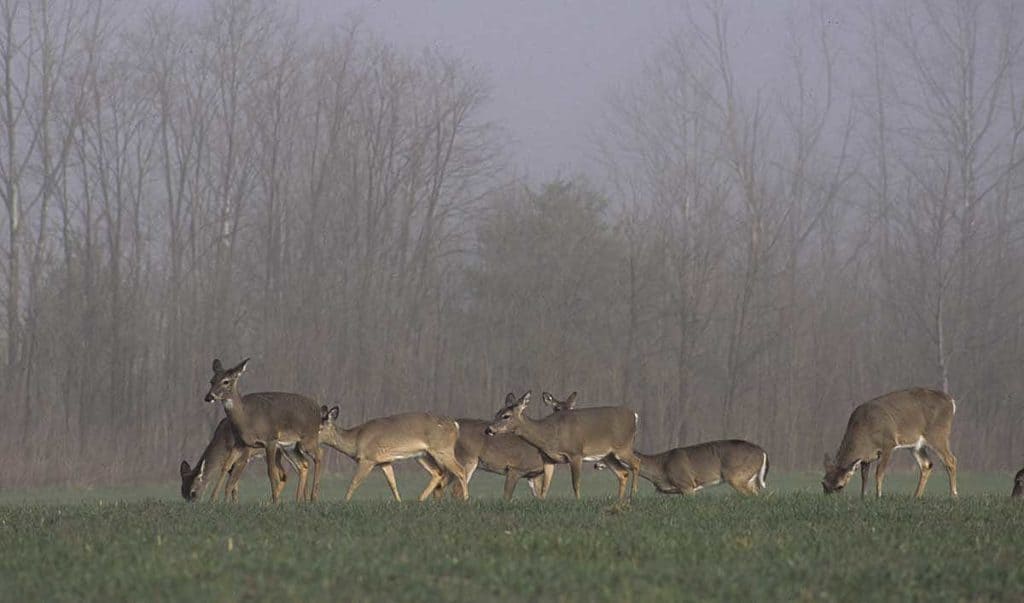By Steve Felgenhauer
If you grow it, they will come. At least that’s the hope of hunters who put in the hard work, sweating in the hot late-summer sun, turning dirt and putting seed in the ground. Food plots are a big investment not only in money but time and other resources.

A well prepared food plot provides beneficial nutrition to your deer herd and other wildlife, and it can also improve your hunting.
Done right, food plots can not only greatly improve your hunting success, they are also a key ingredient to any management program, improving the quality of deer and other wildlife.
Preparation is the key to a successful food plot, according to whitetail expert Dr. Grant Woods of GrowingDeer.TV, a weekly online show featuring Woods’ famed Proving Grounds in southwest Missouri.
What’s In Your Soil?
Woods explains, “Plants are simply nutrient transfer agents. Some plants transfer better than others. You might plant the soybeans, and they might turn green and the deer eat them, but without the proper nutrients in the soil, they won’t get full benefit from the crop or your hard work.”
Make the assumption that the soil on every food plot is in bad shape. If it was good soil, it would have a commercial crop growing on it.
Most hunting-land dirt needs some tender loving care—in the form of 50-lb. bags and spreaders. But don’t guess. Find out what your soil needs.
Four Rules of Food Plot Preparation.
- First and foremost perform a soil test. “If I cannot afford a $15 soil test, I cannot afford to plant a food plot,” says Woods.
- Lime to fix the soil pH—the acidity of the soil—if needed. Again, if you cannot afford to get the pH of the soil right on a food plot, you cannot afford to plant a food plot.
- Use the appropriate fertilizer. It’s common for hunters to waste money by putting more seed out than is needed, and then neglecting fertilizer. Deer know which plants are most nutritious. Fertilizer will make your plot more lush and nutritious.
- Think about the right seed types and where to plant, but don’t skip the above steps. “Most folks worry about what seed to plant first. If you don’t take care of the first three things, the food plots will most likely fail,” said Woods.
Fall Food Sources
Most fall food plots need to be planted 60 days before the first frost. But if there’s not enough moisture in the soil, it doesn’t matter what you plant, and you are wasting time and money. The most important element of a successful fall food plot is soil moisture content.
Woods’ favorite cool-season crop is radishes.
“Radishes go from germination to palatability much faster than a purple top turnip or other brassica,” says Woods, who points out brassicas are a great food source to transfer minerals to deer.
Woods recommends planting a blend to hedge your bets rather than a single monoculture planting. He plants radishes, wheat and turnips together in the same plot. Not only does this ensure a crop in the food plot, but also each of the crops matures at different times. The deer will eat the radishes first then the wheat and later they will start on the turnips. This makes your food plot more attractive to the deer for more months.
Before choosing a seed combination for your plot, do some research. Find a hunting message board in your area and ask what others hunters have had success planting, or speak with a local county agriculture agent about planting dates and preferred seeds for local food plots.
Hunting the Food Plot
Contrary to many hunters’ ideas of food plots, Woods will only put in a food plot where he can approach it and exit without spooking deer.
“Food plots don’t do any good if you can’t hunt them, Woods explained. “Everyone worries if there’s deer sign next to my food plot but approaching the deer stand is more important than stand location. Stand placement is a given if the wind is right, but if you can’t get into the stand without alerting deer, you won’t kill mature deer.”
Putting up your stand during daylight and then setting up a trail camera on the tree your stand is hanging will condition the deer to avoid the area during daylight hours. Many of the properties Woods manages utilize GPS collars on the deer and rather than theorize, Woods has the GPS readout to prove his findings. One of the most interesting of these findings is not hunting the actual food plot.
“Our GPS records show setting up about 200 yards from the food plot between the bedding area and the food plot is much more effective than overlooking the food plot,” concluded Woods.
Do the prep work before you do the sweat equity of actually planting a food plot, and you’ll be much more likely to have a lush green field this winter that’s a deer magnet and a great food source for all wildlife on your property.
The Union Sportsmen’s Alliance website is designed to provide valuable articles about hunting, fishing and conservation for members of AFL-CIO affiliated labor unions and all sportsmen and sportswomen who appreciate hunting and fishing and want to preserve our outdoor heritage for future generations. If you would like your own story and experience from the outdoors to be considered for our website, please email us at USAmembers@unionsportsmen.org.



